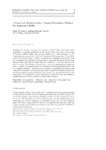A low-cost decision-aided channel estimation method for Alamouti OSTBC

Use this link to cite
http://hdl.handle.net/2183/15451Collections
- Investigación (FIC) [1685]
Metadata
Show full item recordTitle
A low-cost decision-aided channel estimation method for Alamouti OSTBCDate
2013-11Citation
Castro-Castro, Paula-María, P., Dapena, A., García-Naya, J. & Labrador, J. 2013, "A low-cost decision-aided channel estimation method for Alamouti OSTBC", Neural Computing and Applications, vol. 23, no. 6, pp. 1597-1604.
Abstract
[Abstract] In wireless communication systems, channel state information (CSI) acquisition is typically performed at the receiver side every time a new frame is received, without taking into account whether it is really necessary or not. Considering the special case of the 2 × 1 Alamouti orthogonal space-time block code, this work proposes to reduce computational complexity associated with the CSI acquisition by including a decision rule to automatically determine the time instants when CSI must be again updated. Otherwise, a previous channel estimate is reused. The decision criterion has a very low computational complexity since it consists in computing the cross correlation between preambles sent by the two transmit antennas. This allows us to obtain a considerable reduction on the complexity demanded by both supervised and unsupervised (blind) channel estimation algorithms. Such preambles do not penalize the spectral efficiency in the sense they are mandatory for frame detection as well as for time and frequency synchronization in current wireless communication systems.
Keywords
CSI acquisition
Alamouti code
Supervised and unsupervised estimation
Hybrid adaptive algorithms
Batch learning
Alamouti code
Supervised and unsupervised estimation
Hybrid adaptive algorithms
Batch learning
Description
The final publication is available at Springer via http://dx.doi.org/10.1007/s00521-012-1112-1
Editor version
ISSN
0941-0643 (Print)
1433-3058 (Online)
1433-3058 (Online)





